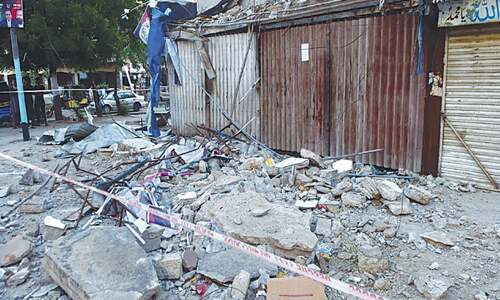A young man with watery eyes sits on a raised floor. He has folded his legs and pushed the knees close to his chest in a forlorn posture. He looks skywards and then his head starts bobbing like a yoyo, as if in a trance. You don't know if he's a regular visitor or someone who has devoted his life to this compound. What can't be disputed is: the young man is a devotee of Zinda Pir. He is known as mastana and is originally from a village called Wasti Thosa in Dera Ismail Khan.If you're not familiar with this area, it may take you ages to reach Sakhi Zinda Pir's shrine. But for his followers, it's not difficult at all to come here and pay homage to the saint or offer Fateha to the pir whose real name is Syed Mehmood Shah Bukhari. Zinda Pir means the living saint. Why living? Let's keep that for some other occasion. The reason for alluding to him is that Railway Colony behind the Cantt Railway Station is famous for this mystic's resting place and not so much for the once thoughtfully constructed, pre-partition residential buildings for railway employees (not to be confused with the old locality where the department's officers reside). If you are into architecture and history and haven't been to this neighbourhood, you don't know what you're missing out on. It's a world unto itself, albeit a small, shabby and poor one.
Getting into the colony from the side where the Railways Diesel Workshop/Shed is located by plying an uneven, bumpy road may suggest that there's nothing special to this locality. There are lines of thrown-together quarters spread at a distance from each other, with large chunks of uncovered garbage dumps and ponds of filthy water bordering them. It's a sight ought to be discounted if you're to witness the vestiges of our history that can be found here.
Turn right from where there's a school run by an NGO and you'll chance upon a couple of big apartment buildings made of stone. These are nice structures, and their most prominent feature is the stone used in their construction, which appears to be pretty much intact. They are two-storey buildings with very little embellishment. The number of decorative elements is minimal. Again, it's the stone (or so it looks) that catches your eye. It still hasn't lost its sheen to a reasonable extent. Is that the true picture? Not sure.
Saad is a student of the mass communications department, Urdu University. He lives in one of the buildings. He says: “The sewage system is in a shambles. Water seepage is causing a lot of damage. The water that comes from underneath has already harmed a fair portion of the ground floors.”
His elderly neighbour chimes in, “If it rains, it takes us at least two weeks to get rid, or drain off, the water that gets accumulated in and around the structures. They haven't even yet metalled the road (Railway Colony Road) because some high-ups don't want it to so. It is a major worry for us.”
Moving ahead of this block and a bit of zigzagging will lead you to the shrine. On the left of the mazar there are some other remarkable apartment blocks. Though residents have made additions to their balconies and rooftops which look quite ungainly, the overall visual effect of the constructions is pretty striking. Perhaps the only thing that can be complained about with reference to their architecture is the narrow, somewhat tapering rectilinear windows. The reason for it could be that, despite having reasonable symmetry, the facilities were not made for the high-ranking officials of the department. Just a conjecture!
One of the structures has a unique look, in the sense that there are not many (perhaps none) pieces of architecture of this shape in Karachi. It is the same building as the rest of its counterparts, except that it has a semicircular front which imparts a strange appearance to it. You wonder why?
Architect Arif Hasan says: “You've mentioned the smallish windows in the buildings. If you see the bungalows that were made by the British for railway officers, they used to have baramdas or open spaces. It took care of the dhoop (sunshine) and they could afford big, spacious windows. But when they made flats or apartments for the workers, the size of the windows was invariably small, primarily to get less dhoop, which in this part of the world can be scorching in the summer. If you go to Keamari, you'll come across similar examples of construction with narrow windows, facing west.”
The sun has just slid out of a dark cloud. Mastana has shielded his face with his left hand. He cannot keep his hand up for long to evade the sun. So he turns around and faces a stone building. His head is still now! mohammad.salman@dawn.com














































Dear visitor, the comments section is undergoing an overhaul and will return soon.